ISSN ONLINE(2319-8753)PRINT(2347-6710)
ISSN ONLINE(2319-8753)PRINT(2347-6710)
Lavanya S1, Sathishkumar R2
|
| Related article at Pubmed, Scholar Google |
Visit for more related articles at International Journal of Innovative Research in Science, Engineering and Technology
ABSTRACT— When hybrid power generation system integrated to power system it produces major stability and control problems. The influence of the hybrid system in the grid system concerning the power quality measurements are the active power, reactive power, voltage deviation, flicker, harmonics, and electrical behavior of switching operation and these are measured according to International Electro-Technical Commission (IEC). The STATCOM provides reactive power support to hybrid system and load. The Battery Energy Storage System (BESS) is generally required to compensate the fluctuation generated by hybrid system. The proposed Inverter control scheme to mitigate the power quality issues for power quality improvement in the grid connected hybrid power generation system is simulated using MATLAB/ SIMULINK in power system block set. The control scheme has a capability to cancel out the harmonic parts of the load current and maintains the source voltage and current in-phase. The performance of the system using PI and FUZZY controller has been studied comparatively.
Keywords |
| Power Quality, Battery Energy Storage System, Fuzzy Logic Controller, Hybrid Power Generation System. |
INTRODUCTION |
| The increasing number of Renewable Energy Sources and Distributed Generation (DG) requires new technique for the operation and management of the electricity grid to enhance power supply reliability and power quality. The distributed generation and in integration of Renewable Energy Sources into the grid provides power quality problems. By using renewable energy sources we can get pollution less environment and it is available enormously in nature. Power shortage is reduced by implementing distributed generation. The power electronic loads place a major role in industries. These nonlinear loads inject harmonic currents in the AC system and increase overall reactive power demand by the equivalent load. The major power quality problems are from system to load voltage sag/swell, voltage unbalance, voltage distortion and interruptions and from load to system are current harmonics, reactive current, current unbalance, voltage notching and voltage flickering [1]. These problems can be mitigated by using various techniques. Proportional Integral (PI) control [3] instead of power converter is implemented to manage reactive power interchange between wind farm and grid. To control power converter, a new current sharing approach is proposed in [4]. Pulse Width Modulation (PWM) based controller operates the inverter circuit to give a desired output. When turbine starts high frequency current flows through rectifier circuit and then stores into the dc-link capacitor. Instead of using dc-link capacitor storage device [3],[4] separate Battery Energy Storage System (BESS) is proposed in [5]. By using State Of Charge (SOC) technique BESS control is done. State Of Charge (SOC) technique proposed in [5] investigates with cascade pulse width modulation are presented in [6]. The experimental system includes no voltage-balancing control because it uses nine NiMH battery units that have an almost flat charge/ discharge voltage profile. In [10] STATCOM based control scheme [5] for power quality improvement in grid connected wind generating system and with nonlinear load is presented. This method reduces harmonic parts of load current. It maintains the current and source voltage in phase and also compensates reactive power demand only but produce harmonics [4],[9]. The operation of the control system developed for the STATCOMBESS in MATLAB/SIMULINK for maintaining the power quality is simulated. Toovercome these issues I proposed this paper. |
| In this paper inverter control is implemented to maintain unity power factor and power quality in the point of common coupling. Active and reactive power compensation is obtained because of the absence of FACTs devices. It also cancels harmonic current in the system. Separate Battery Energy Storage System also proposed in this paper. It will give rapid response and enhance the voltage stability of the system under fluctuation of wind turbine output. |
HYBRID POWER EXTRA CTION WITH BATTERIES |
| The proposed hybrid power extraction from wind generator and solar panel with battery energy storage with distributed network is configured on its operating principle and is based on switching the inverter by using control strategy for critical load application is shown in fig. 1. |
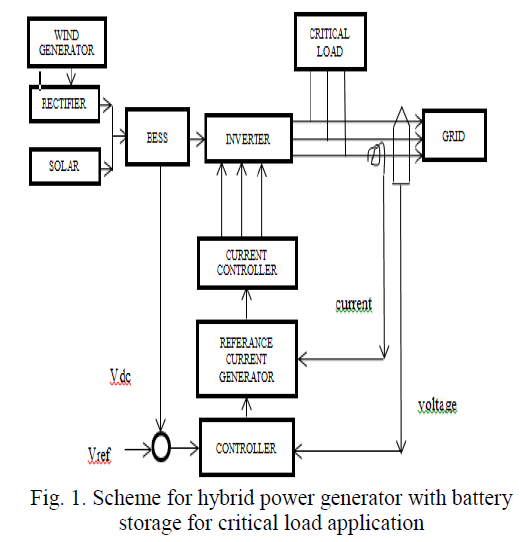 |
| A.Wind Energy Generating System |
| It consist wind turbine, Permanent Magnet Synchronous Generator and diode rectifier to get dc bus voltage. The below mathematical relation gives wind turbine characteristic in the wind as in |
 |
| Where ρ denotes air density (1.225 kg/m3), Vwind denotes the wind speed in m/s, and R denotes the rotor radius in meters. It is not possible to extract all kinetic energy of wind is called power coefficient. It is a function of tip speed ratio and pitch angle. |
| PMSG speed-power characteristic is given in fig. 2. |
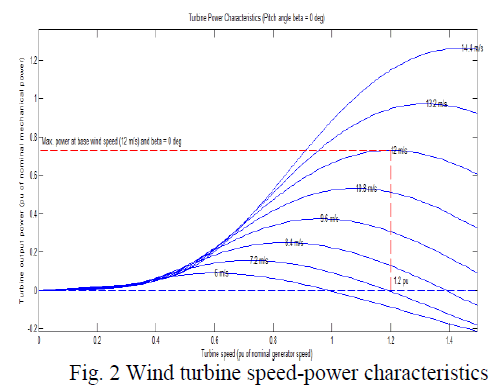 |
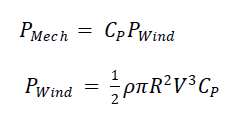 |
| B.Solar System |
| Photo-Voltaic (PV) cells produce electricity from sun. Materials used in computer chips are similar to materials used in PV cells. These materials absorb energy from sunlight, which isolates the electrons from their atoms and allows them to generate electric power. PV cells are great because they don‘t require regular maintenance, are eco-friendly, and don‘t produce pollution in any form. The PV array is constructed solar cells. Each solar cell formed by a PN junction semiconductor, which produces currents by Photovoltaic effect. Fig. 3 shows solar cell parameters. |
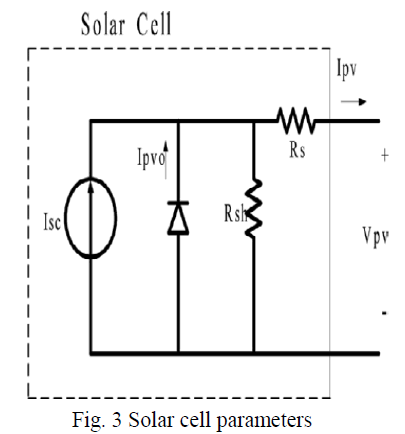 |
| Current and voltage values injected from PV cell can be calculated by using formula given below. |
 |
| Where Rs&Rsh- Series and Shunt resistances respectively. |
| Isc - The light induced current, |
| N- The ideality factor of p-n junction, |
| 0-The diode saturation current, |
| K - Boltzmann constant (8.63 × 10−5 J/âÃâæK), |
| Q - The electronic charge. |
| always depend on the irradiance level S’and the array temperature T‘. |
 |
| Where Irefis the short-circuit current under the reference irradiance strength Sref and temperature Tref, htis the cell module temperature coefficient, while Ipvo depend on T only. |
MODELLINGOF INVERTER CONTROL |
| A. Using conventional PI controller |
| The inverter control by using PI based voltage regulator is shown in fig. 4. |
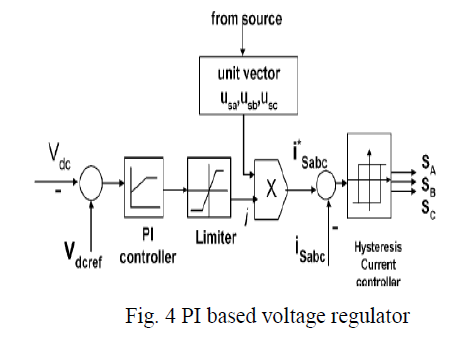 |
| B. Using Fuzzy controller |
| Fuzzy Logic Controller is fed by one input that is voltage error. This gives the source current output. Fig. 5 shows FLC based voltage regulator. |
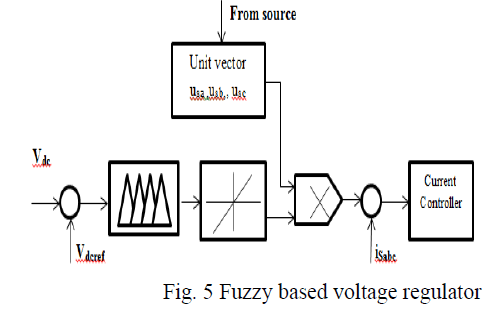 |
| The control scheme is simulated using SIMULINK power system block set. The system parameters for given system is listed in Table 1. |
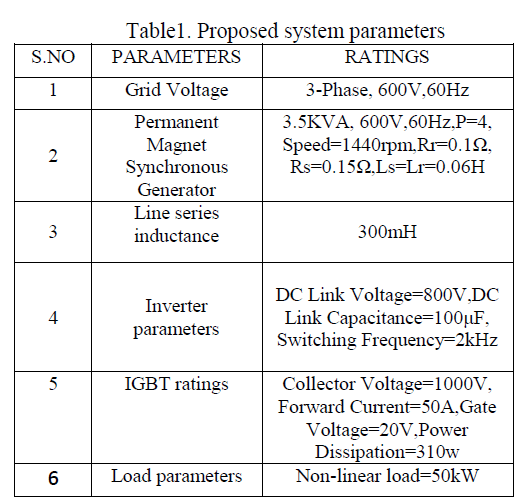 |
FUZZY LOGIC CONTROLLER |
| A Fuzzy controller can include empirical rules, and that is especially useful in operator controlled plants. Fuzzy logic controller (FLC) is capable of improving its performance in the control of a nonlinear system whose dynamics are unknown or uncertain. Fuzzy controller can improve its performance without identifying the model of the plant. Fuzzy control is almost similar as that of the classic closed-loop control approaches but it differs in some factors, it is imprecise and symbolic notations for precise numeric measures. The fuzzy logic controller assigns the input values from the real world. FLC voltage regulator is fed by one input that is voltage error (Ve).The rules for the proposed FLC voltage controller are: |
| i) If âÃâ¬ÃâVe‘ is âÃâ¬ÃâENVVH‘ Then âÃâ¬ÃâI‘ is âÃâ¬ÃâINVVH‘ |
| ii) If âÃâ¬ÃâVe‘ is âÃâ¬ÃâENVH‘ Then âÃâ¬ÃâI‘ is âÃâ¬ÃâINVH‘ |
| iii) If âÃâ¬ÃâVe‘ is âÃâ¬ÃâENH‘ Then âÃâ¬ÃâI‘ is âÃâ¬ÃâINH‘ |
| iv) If âÃâ¬ÃâVe‘ is âÃâ¬ÃâENM‘ Then âÃâ¬ÃâI‘ is âÃâ¬ÃâINM‘ |
| v) If âÃâ¬ÃâVe‘ is âÃâ¬ÃâENL‘ Then âÃâ¬ÃâI‘ is âÃâ¬ÃâINL‘ |
| vi) If âÃâ¬ÃâVe‘ is âÃâ¬ÃâEZ‘ Then âÃâ¬ÃâI‘ is âÃâ¬ÃâIZ‘ |
| vii) If âÃâ¬ÃâVe‘ is âÃâ¬ÃâEPL‘ Then âÃâ¬ÃâI‘ is âÃâ¬ÃâIPL‘ |
| viii) If âÃâ¬ÃâVe‘ is âÃâ¬ÃâEPM‘ Then âÃâ¬ÃâI‘ is âÃâ¬ÃâIPM‘ |
| ix) If âÃâ¬ÃâVe‘ is âÃâ¬ÃâEPH‘ Then âÃâ¬ÃâI‘ is âÃâ¬ÃâIPH‘ |
| x) If âÃâ¬ÃâVe‘ is âÃâ¬ÃâEPVH‘ Then âÃâ¬ÃâI‘ is âÃâ¬ÃâIPVH‘ |
| xi) If âÃâ¬ÃâVe‘ is âÃâ¬ÃâEPVVH‘ Then âÃâ¬ÃâI‘ is âÃâ¬ÃâIPVVH‘ |
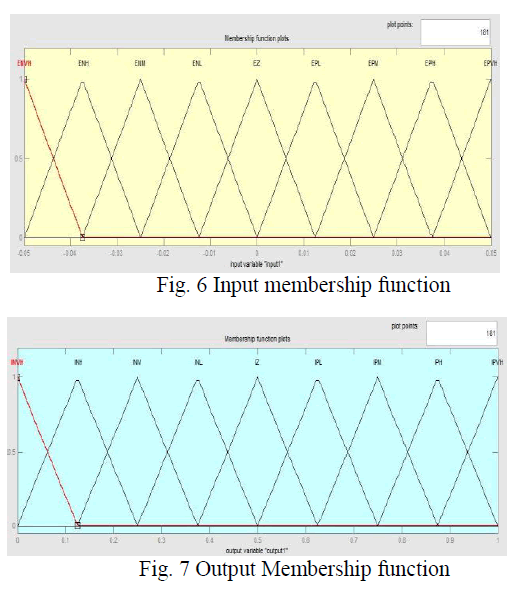 |
RESULTSAND DISCUSSIONS |
| The hybrid power generating system is integrated with the grid having critical load. Due to variation in hybrid power generation and nonlinear load source current of the grid affected. The three phase injected current into the grid from Inverter will cancel out the distortion caused by the non-linear load.Figure 8 shows the source current and voltage waveform of the test system without Inverter Control and the Figure 9 and 10 shows the corresponding FFT analysis waveform. From FFT analysis, it is shown that the Total Harmonic Distortion (THD) of the source current and voltage waveforms of the test system without Inverter Control are 24.42% and 25.03% respectively |
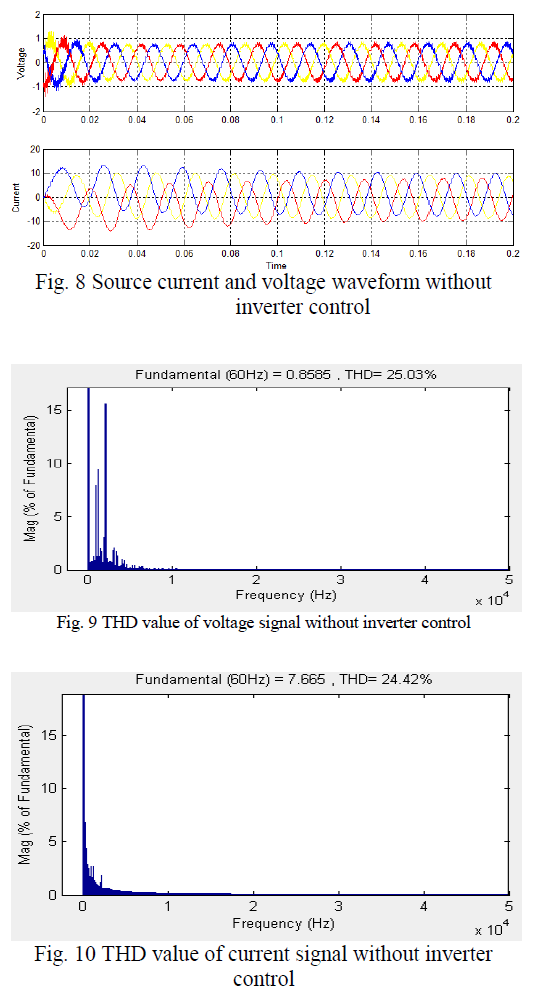 |
| A. Using PI Control Strategy |
| Figure 11 shows the source voltage and current waveforms of the test system with PI controller based INVERTER and the Figure 12 and 13 shows the corresponding FFT analysis waveform. From FFT analysis, it is observed that the THD of the source voltage and current waveforms of the test system with PI controller based INVERTER are 2.95% and 0.79% respectively. |
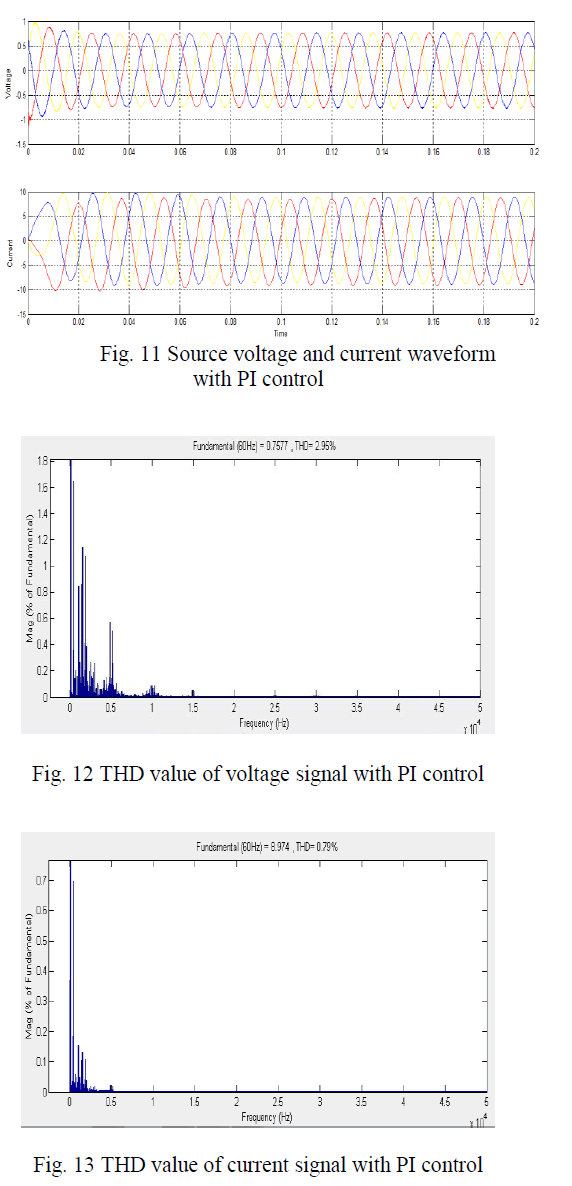 |
| B. Using Fuzzy Controller |
| Figure 14 shows the source voltage and current waveforms of the test system with FLC based INVETER control and the Figure 15 and 16 shows the corresponding FFT analysis waveform. It is shown from the FFT analysis, THD of the source voltage and current waveforms of the test system with FLC based INVERTER control are 0.49% and 0.29% rep. Thus, it is observed that there is a further reduction in the THD value of the source voltage and current waveforms. |
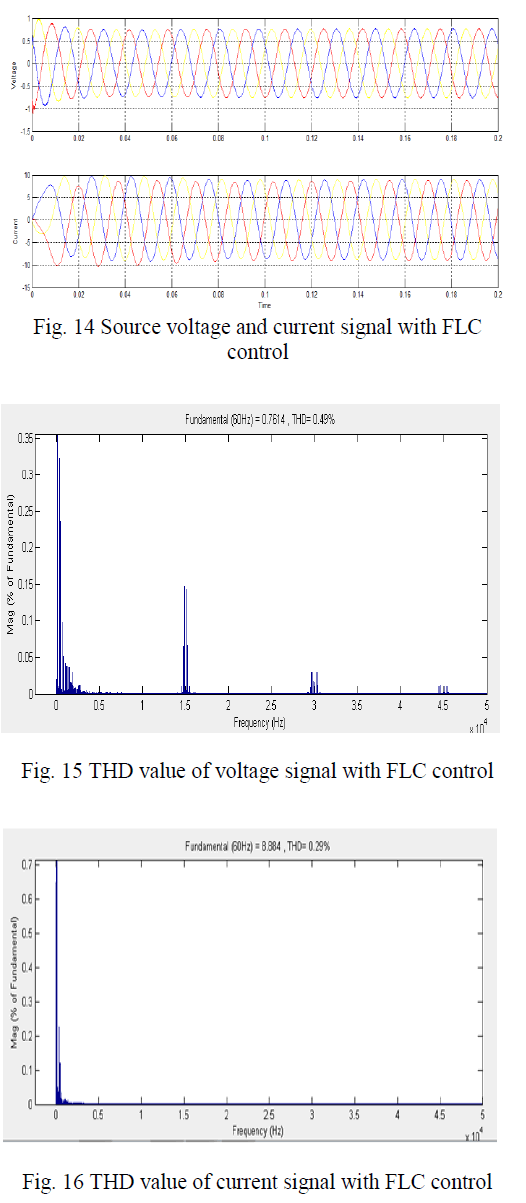 |
CONCLUSION |
| The wind-solar hybrid system with battery energy storage and an inverter in current control mode for exchange of real and reactive power support to the non-linear load was proposed. The Fuzzy Logic controller based inverter control strategy has been developed for grid connected wind-solar hybrid system. Distributed Generation produce harmonics when integrate with grid sources. By using suitable control circuit this harmonics are reduced. The fuzzy logic controller based INVERTER is presented for grid connected Wind Energy Generating System. The proposed FLC based INVERTER have improved the power quality of source current significantly by reducing the THD from 22.45% to 0.29 %. It is clearly presented that INVERTER with FLC gives better performance than INVERTER with conventional PI controller. |
References |
|